


new to teaching but old to the love of learning
As one of my projects to show evidence of my learning, I decided to make a PowerPoint summary of the final topic, sharing resources & practicing open learning. To create this learning reflection, I read the three readings given to us in our topic resources and compiled a set of keynotes I found most useful/intriguing throughout the three articles. In doing so, throughout these readings, I was able to critically reflect on the importance of open research and open data in an educational setting. I was also able to practice my digital literacy in using a program I am not comfortable with (Microsoft PowerPoint). In doing so, I can take the knowledge I learned from creating this presentation to and use this program to aid in my lessons and teaching resources in an open and online learning environment.
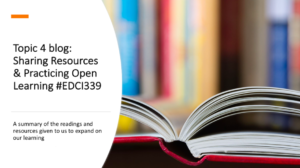
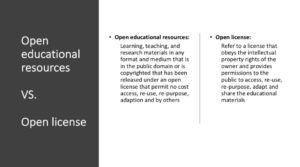

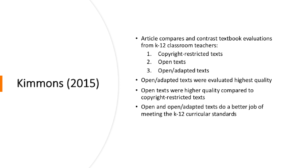
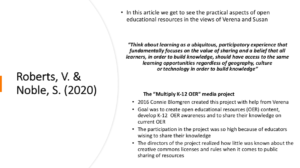
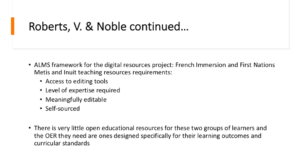
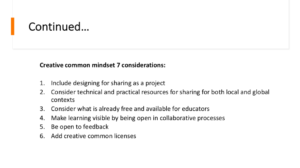
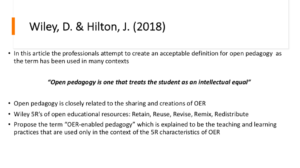
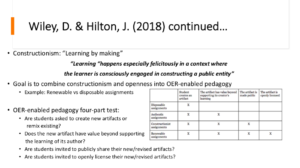
Individual blog post #2: How would you describe the historical and theoretical trends in k-12 online and distributed learning? What did you already know, what do you know now based on the course readings and activities, what do you hope to learn?
The readings, topic notes, and webinar for topic 2 “Historical & theoretical context of K-12 online & open learning in Canada” gave me a new perspective on how far online learning & open learning has come in Canada and also how far it needs to go. Before taking notes and annotating with my peers, my knowledge I realize for this type of learning was very scattered and somewhat incorrect. If anything, before this topic, the closest I got to learning more about online learning and the benefits and difficulties it brings for both the student and the teacher was through watching my two elementary school teacher parents convert over to an online platform.
One of the most crucial pieces of information I learned was how “new” and “ill-researched” this topic is. Delving into the readings the very first thought made by me was how it took over 20 years for any form of a re-examination of formal research to be conducted on these topics. My theoretical thinking for this reasoning is that: The dramatic evolution of technological resources and hardware over the past decade has brought vast advancements compared to the course of the past 20 years which is why a new examination of online learning was needed.
During the course readings I learned a lot about Canada and how it finances its e-learning education, and needless to say I was surprised at times. Compared to the rest of the world Canada ranks quite high amongst the nations of the world in the category of “educational spending per capita” (Barbour, M & Labonte, R, 2018, p. 601). However, each province and territory is responsible for funding, creating curriculum, and managing their educational programs meaning there is no national funding, policy, or governing (I never understood the point of having 13 different curriculums). According to this article and my fellow peer Leona Ngan, the provincial/territorial funding is distributed equally amongst private and public schools on “per-student funding based on enrollment” (Barbour, M & Labonte, R, 2018, p. 601) regardless of the external/independent funding that these schools may be getting elsewhere (Ngan, L, 2020).
Historical trends in k-12 online and distributed learning:
1919: Correspondence school opens in Canada, British Columbia
1945-95: First virtual school is established in Canada. Avon Maitland Distance Education Centre in Ontario
1995-96: First virtual school to offer multiple courses opens. Electronic Distance Education Network in Ontario
1995-99: Several K-12 online learning programs are developed and operated in Alberta
2008-12: Distance education and online learning flourishes in all 13 provinces and territories
2013: CANeLearng national non-profit is launched to “provide leadership that champions student success by supporting organizations and educators involved in online and blended learning through networking, collaboration, and research opportunities”
2015-16: Of the 5.1 million students enrolled in education programs in Canada 5.7% of the population was enrolled in e-learning
2017: Francophone K-12 eLearning community is established
2018: Every Canadian province and territory has some form of online distance learning
(Barbour, M & Labonte, R, 2018, p. 602-611)
Theoretical trends in k-12 online and distributed learning:
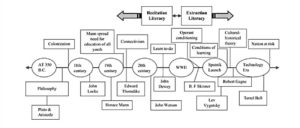
(Edgar, D, 2012, p. 5)
Barbour, M & Labonte, R. (2018) An Overview of eLearning Organizations and Practices in Canada. In R. Ferdig & K. Kennedy (Eds.), Handbook of research on K-12 online and blended learning (pp. 600-616). Pittsburgh, PA: Carnegie Mellon University ETC Press.
Bates, T. (2014). Learning Theories and Online Learning. [Blog post]. Retrieved fromhttps://www.tonybates.ca/2014/07/29/learning-theories -and-online-learning/.
Edgar, D. (2012). Learning Theories and Historical Events Affecting Instructional Design in Education: Recitation Literacy Toward Extraction Literacy Practices. SAGE Open, 2(4), 1-9, https://doi.org/10.1177/2158244012462707
 For one of my portfolio projects, I decided to step out of my comfort zone and join in on the July 23rd Twitter live chat with my #EDCI339 family. How the chat worked was our professor Verena Roberts would introduce to the group every few minutes a new topic question, and it was up to us to answer, reply, comment, and share our knowledge and experience on the topic. To start,
For one of my portfolio projects, I decided to step out of my comfort zone and join in on the July 23rd Twitter live chat with my #EDCI339 family. How the chat worked was our professor Verena Roberts would introduce to the group every few minutes a new topic question, and it was up to us to answer, reply, comment, and share our knowledge and experience on the topic. To start,  I had to initially sign up for twitter as I didn’t have an account already. I found the signing up portion of the app simple and self-explanatory. The only difficulty I had with the entire process is figuring out the little tricks to using twitter. Like Facebook or Instagram, there are options to like people’s tweets and to reply to them. However, once you did reply to a tweet, the interesting part was that the reply didn’t show up attached to the original tweet but instead was a tweet in itself that had a link at the top back to the original tweeters tweet. The entire process of the live twitter chat I would say was more of a learning experience using twitter than one about the topics we were discussing. I ended up feeling very stressed throughout the hour just because of the high volume of replies and comments coming in, and I had feelings of overwhelmedness. Although I had these mixed feelings, in the end, the experience of the Twitter chat gave me more knowledge in the aspects of online and open learning. I was able to witness human-centered learning first hand through the diversity of knowledge being shared, I had the chance to practice my digital literacy by exploring a media app I have never tried before, and I can take this experience of mine and reflect on how I currently and in the future can use Twitter in my future classes and personal pedagogy.
I had to initially sign up for twitter as I didn’t have an account already. I found the signing up portion of the app simple and self-explanatory. The only difficulty I had with the entire process is figuring out the little tricks to using twitter. Like Facebook or Instagram, there are options to like people’s tweets and to reply to them. However, once you did reply to a tweet, the interesting part was that the reply didn’t show up attached to the original tweet but instead was a tweet in itself that had a link at the top back to the original tweeters tweet. The entire process of the live twitter chat I would say was more of a learning experience using twitter than one about the topics we were discussing. I ended up feeling very stressed throughout the hour just because of the high volume of replies and comments coming in, and I had feelings of overwhelmedness. Although I had these mixed feelings, in the end, the experience of the Twitter chat gave me more knowledge in the aspects of online and open learning. I was able to witness human-centered learning first hand through the diversity of knowledge being shared, I had the chance to practice my digital literacy by exploring a media app I have never tried before, and I can take this experience of mine and reflect on how I currently and in the future can use Twitter in my future classes and personal pedagogy.
Of all the topics covered in this course, the one that made me critically reflect the most was topic three, Equity and Access in K-12 Distributed (Online) & Open Learning Environments.
Growing up in a household of two teachers as parents I wasn’t living the most privileged life, however, I never had the feeling of being left on my own, or inadequately able to complete my work. I had access to wifi, technology, and my parental support, all things that a large percentage of students do not. After reading topic three’s readings on what occurred when the pandemic hit and students, teachers, and parents were forced to move to an online school setting I couldn’t help but notice that the readings were missing a very clear perspective, one of the teachers and their feelings towards their student’s differing at-home situations. To find this missing angle, I decided what better way than to talk/interview my very own parents in their experience during the COVID-19 pandemic and hear about their own student’s challenges to access the online learning reality.
This opportunity allowed me to examine and reflect the various means of equitable access students had (and still have) when entering online and open learning contexts. It also shows how these inequalities don’t just negatively affect the student’s but emotionally affect their teachers as well.
Grade two teacher
Situation 1: Single mom supporting a family of three
“Of the kids who went online, I had 13-14 regulars who came on but I had this one little boy who’s family, single mother, did the best she could, she managed to buy each of the three boys a tablet that they could use as an online resource, but the tablet was probably an $80-$100 tablet, which is great but when the boys went online, they couldn’t use Zoom because the audio feature wasn’t compatible to the tablet, they couldn’t actually get on the online chat because the word processor on the tablet wasn’t quality, up-to-date program. The boys didn’t have great internet, so there would be constant glitching where at times you wouldn’t be able to even see the boys or the Zoom video would consistently log him out so I would be receiving messages throughout the meeting from his mom saying “we can’t get on.” What would happen is when we were sharing stories as a class and I knew he had a really good story that he wanted to share we wouldn’t want to ask him to share because we knew he was just going to glitch out, and it was just so sad. This is a family, one who actually tried really hard to participate, and it just wasn’t fair.”
Situation 2: Full family support and access to unlimited online learning tools and technology
“Another student I had, to show the other side of the inequality scale, was a student whose mom and dad were very tech-savvy. So this little boy ended up creating a youtube channel and videos that he would post, make his own script-writing, did his own editing, add music to the videos, and would send thee videos to me that I would post on our class website. He personalized his online learning and was technically was above any of us. It just shows you that it’s not fair. Not only did he have the equipment, the video camera, and the whole set up he could use, he had the parental support. His mom was home 24/7 and when his dad did come home from camps he would help the boy with all of the editing and stuff.”
Grade two/three teacher:
Situation 1: Divorced parents, a mother with mental health and addiction problems and a father who is functionally illiterate
“A boy in my class was living with his dad who is unfortunately almost illiterate and didn’t have any access to wifi or a computer/tablet since he spent most of his time working in camps, so I tried to get him access to one of the school’s resources. On the news, you hear about all these school districts giving away their iPads and resources to students in need thinking just how great the program is when really it is each specific school administrator’s choice whether to or not. So I managed to get in touch with our administrators who gave this boy a ten-year-old iPad that only had access to the school district wifi, so basically, if he wanted to use this iPad he had to be within twenty feet of any school. So that didn’t work. The only time he could get on to my website or our Zoom meetings was when he was with his grandparents, who as well had an computer that didn’t work. During the month of online learning, he got on once. I invited him to email, talked to his dad and his grandparents asking them to help him compose emails to me but he never did.”
Situation 2: Family that didn’t care for online learning
“I had a little girl who didn’t go online once, not because she didn’t have the opportunity or technology to but because the parent said she wasn’t going to participate in online learning. So is just shows that some parents who have the potential to allow their kids this opportunity and to let them virtually learn, just simply don’t want their children to be online.”
Below is a voice-over video of me explaining my learnings of the annotating activity I and my group participated in. We ended up annotating all three of the readings in Topic 2: The history and context of k-12 distributed and online learning and evidence of the other two annotations can be seen in the screen captures in this blog post.
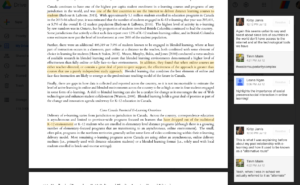
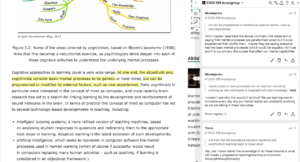
Script used for video:
For one of the optional course activities, I have chosen to do a summary and reflective video about one of the pod activities, my group and I completed. For topic 2, the history and context of k-12 distributed and online learning suggested activity; was for you and your group “meet” to compare and contrast k-12 online and open theory and history based on our course readings. On this screen, I have an example of one of our group meetings using the google chrome extension Hypothes.is. The program allowed us to annotate the reading and also reply to other member’s annotated comments. I was surprised by just how conatively engaging this exercise turned out to be. I felt more involved in the article and interested because I was able to not only record my thoughts but read other people’s views and then re-think my own. Having the opportunity to reply to other comments allowed us as individual minds to work together to answer one another’s questions, question each other’s thoughts, and understand the content to a deeper level. This activity allowed me and my group to practice our digital literacy by experiencing and learning about a program new to us all that can aid us in our future collaborations and teaching.
© 2025 Kirby's Education Journey
Theme by Anders Noren — Up ↑
Recent Comments